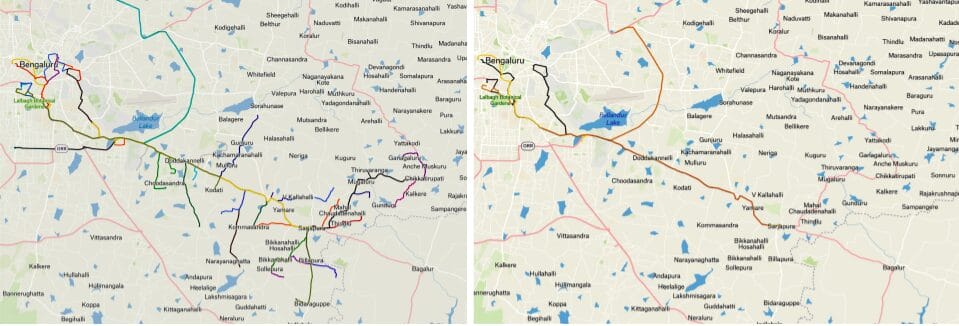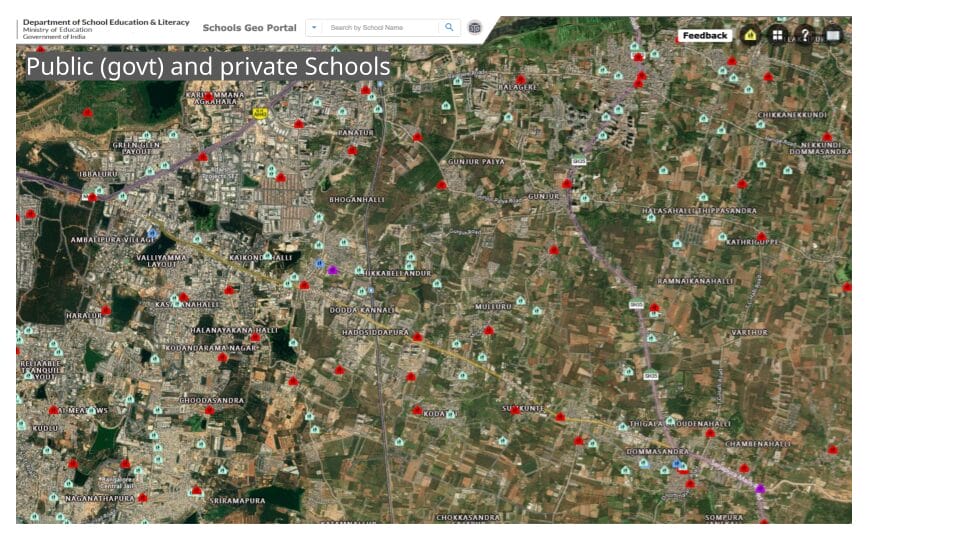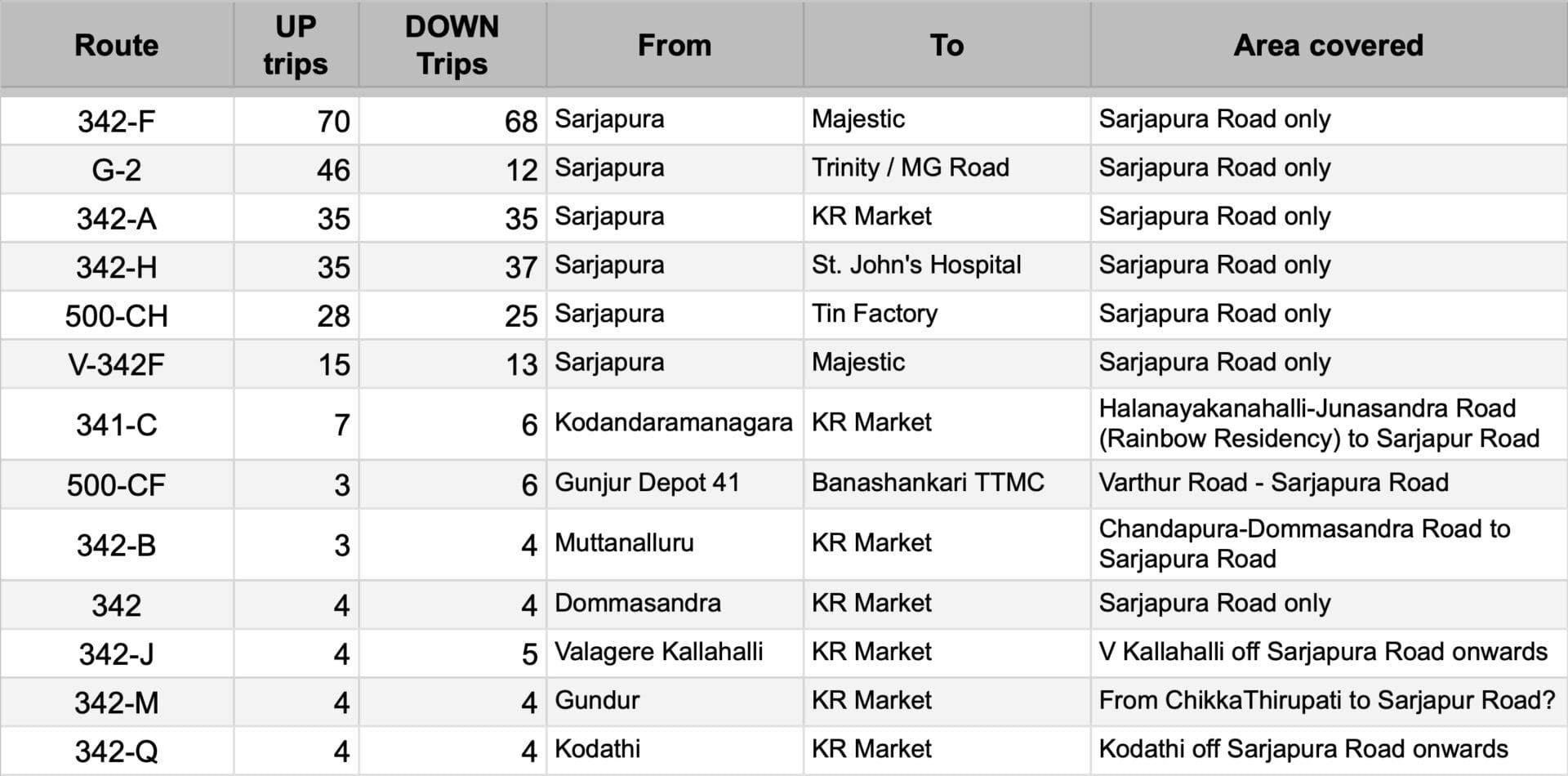The infamous Outer Ring Road (ORR)-Sarjapura Road traffic chaos is something every Bengalurean knows of. Some of us living in the neighbourhood live through this every day. All thanks to the poor quality of both the road network and public transport services. Neither planners nor politicians have paid enough attention to this area to make it livable!
Sarjapura Road is an integral connection to the IT corridor of south-east Bengaluru. Given that the Outer Ring Road (ORR) is almost fully developed, with a focus on tech parks, new residential projects are happening on or around Sarjapura Road, especially the sub-arterial roads feeding into Sarjapura Road (the areas between the radial Hosur Road and Whitefield-Marathahalli Road).
Most of these roads are erstwhile village roads – narrow and potholed. Yet, humongous residential apartments housing thousands of residents (and their cars) have come up here. To add to this, these localities are served by a limited number of bus services.
SoS – Save our Sarjapur Road – a coalition of residents groups in the neighbourhood – has launched a campaign to find solutions to traffic issues.
Our survey of residents showed 50% of respondents drive their personal vehicles and the situation has affected their wellbeing. 1 in 3 respondents said they avoid social outings. 28% say they experience stress and road rage. 50% spend 1-2 hours on the road daily, both in the morning and evening.
To support the demands for solutions, please sign https://act.jhatkaa.org/campaigns/save-our-sarjapura
Read more: Traffic congestion, chaos reigns at the Sarjapur-Attibele junction
Even kids spend hours in traffic
Sarjapura Road also boasts of the largest network of schools in the city (we estimate almost a hundred schools), catering to the vast number of people living in south-east Bengaluru: These schools are well reputed to the point that many international students also come to study in these schools!
While most students use school buses, the congestion forces them to spend hours on the road, breathing noxious fumes. By the time they get to school and return home, they are exhausted and have little time for play and learning.
Why is it so bad?
Almost anyone who commutes on Sarjapura Road knows exactly why the commute is bad. This has been adequately articulated in the press, but the reasons are broadly as follow:
- Road width is nonuniform
- Junctions are not scientifically designed, and there are no grade separators
- There is relatively poor “functional” bus connectivity
The last reason is arguably the most important aspect of the problem. It is precisely because public transit is unattractive that people switch to private vehicles. Single occupancy vehicles (especially cars) compound the problem further, making the choke of traffic still worse and the commute experience even worse.
The BMTC bus route line is primarily aligned from Sarjapura Road to KR Market, but is losing sight of the crucial connection to the IT corridors (Bellandur, Marathahalli, Hebbal).

Amongst these routes, the only routes that stand out with frequency are 342-F/A/H & G-2, and the first three routes are mostly co-incidental. There are no significant connections to ORR from Sarjapura Road. The frequency of Vajra AC buses on V-342-F is also very poor compared to demand.
Most routes that service the inner areas have 1-3 trips a day – designed originally perhaps to service villagers taking their produce to the market. Some of these routes like 340J (Huskur-KR Market) and 341A (Haralur-KR Market) do not exist anymore.
Read more: A guide to bus commute for Sarjapura Road residents
Missing last mile connectivity for BMTC buses
For many residents, there is no bus stop within 500 metres of their homes. Clearly, those who can afford to, use private vehicles. Others walk or use informal shared auto arrangements.

What can be done to improve bus services?
Here are some immediate steps that can alleviate the problem:
- Rationalise the routes: ORR and Whitefield are clearly the major end point, but no bus transit system is complete without connectivity to major residential hubs, such as Sarjapura Road:
- Increase frequency
- Ply more AC/ Vajra buses
- Ensure last mile connectivity. For smaller width roads (e.g. Haralur and Kasavanahalli, Gear school road), it is imperative to look at mini buses or allow shared auto/ cab systems to operate. This allows commuters to get into “the bus grid”:
Sustainable transport: Win-win for all
A recent survey, conducted with close to 1,800 respondents living in the neighbourhood, confirmed people’s willingness to switch to public transport, provided comfortable bus options are available.
Many companies are revising their work-from-home policies requiring employees to spend more time in their offices.
The IT sector in Bengaluru contributing to a major part of the country’s software economy cannot be hijacked by problems of congestion and time wasted unnecessarily on arduous commutes, reducing productivity in the sector. This problem has to be addressed, and in an imaginative way. The city has to invest in sustainable, multi-modal transport infrastructure, a combination of Bus, Metro, Suburban Rail for comprehensive reach and coverage, as well enable safe options for walking and cycling
The first concrete step in this direction should be to “Fix the Bus”; among the nation’s major cities, BMTC has a good track record – its coverage, quality, reach, dependability, and customer focus are major pluses.
By doing this, residents, especially their school-going children will have a smoother time on the roads. By placing buses on lucrative, in-demand Sarjapura routes, BMTC will be able to operate more efficiently. Providing sustainable forms of transport would decrease pollution. Truly a win-win for all.


if comfort is considered top most reason then single driven office car commute will never come down. Either companies have to restrict parking or govt should force high congestion fee else there is no solution in sight. Govt can tax companies depending on parking slots to discourage office car commute. Without a little forced hardship nothing will change.
sir when i was in college just for 11 kms i had to change 3 buses in order to avoid stink and fully packed bus. situation is the same. bus in bangalore will never improve. no proper roads no perfect timimgs. rowdy type drivers and conductors. peak hours bus dont come at all. Earlier BTS full form was BITTARE THIRUGA SIGUVUDILLA.
No direct BMTC service from Sarjapura to Silk Board and Bansankari.
Most of apartment and commercial spaces in Sarjapur area are approved on FAR /fsi calculated on the CDP 2015 road width. Road widening hasn’t happened. There should be writ/pil filed in high court seeking ban on such practices. The bbmp- political real nexus would then be compelled to fix roads build new roads else the land parcel would be dead investment.
Sometimes it’s not wise to discuss every problem from “public” perspectives, but also to see the limitation of the so called public, before the growing clout if private interests of people. These private interests (t just blaming corporates and companies but the private outlook of people together). Today it’s time to make private capital responsible for inclusive development by taking active part with public agencies. When we the private people didnt care to critically understand, how the farming land are accumulated since many years to create international schools and university and IT/BT structures etc., that has become the problem of road infrastructure today, to we the people who are increasingly securing jobs in such ventures. We all see how the accumulation of capital by individuals ( through their work at the high standard institutions) is increasingly demanding all sorts of exclusive development over further accumulation of local land and dispossessions for metro, public transport wtc. Let’s make both private and public equally responsible to make planned investments. Let the development plans first look into basic infrastructure for all communities low and high income people, people of different cultures and beliefs and most importantly an efficient land management which can prevent people getting continuosly dispossessed to feed the private interests of people. Most importantly before flocking into the cities, people also should be responsible to understand the history of place and it’s evolutions as IT/BT corridors. Then people can understand that, it’s not just about the government and we the private people are creating all the problems by blindly flocking into cities paying high salaries and high standard of life such as international schools and then keep complaining about the city and public transport systems. There is a need for more private initiatives today to check the problems and we have to make it private and public. We also need to know why the cities like Bangalore are getting crowded whereas there is enough place on earth to make an alternative living. We never strive for that but to demand more burden on already burdened city. Anyways I am also part of it and I do now understand the need to look for alternative living away from big cities. A small contribution to a huge problem.
Knowingly sarjapur road from agra were villages with agricultal lands with small bullock cart roads how did any corporate companies started , with proper understanding with govt officials first roads should have been developed , lands by cheating farmers for lesser price were purchased without proper infrastructure commercial builders built , know people are suffering it is not late let all big builders , multy national companies should should look after problems and do the need full to the people
Completely agree with everything in this article. Personally,I’d quit driving my car if the 342F AC bus were more frequent. In the absence of metro, there’s no other reasonably comfortable commute for me to reach my office at MG Road.
Well written article. Its really a shame how Bangalore bus transport is designed. Among worst route designs and infrastructure. Truly brainless. Plus the metro construction chaos.
There is no connectivity from Hebbal to Sarjapur the bus runs in this route is 500CH..Few more bus has to be added..
Traffic will only improve marginally if the street network isn’t improved. Right now no matter how far you want to travel, chances are if you live on Sarjapura road, you have to use Sarjapura road to travel. A 5 min trip to the grocery store on the adjacent road shouldn’t become a long 5km circuitous trip. Adding roads to the public road network is the only way to reduce distances, which in turn will allow more people to walk/cycle. For e.g. Kaokondrahalli lake is just 2km from Ecospace the way the crow flies, but by road its almost a 5km trip through some of the most traffic riddled junctions. Adding a cycle lane along Saul kere that connects up to Kaikondrahalli’s cycle lane would do a lot more to encourage cycling and reducing traffic than adding cycle lanes on ORR (although ORR should also have cycle lanes). New roads would also allow more buses to reach areas that are not along Sarjapura road more easily.
Meera,
Any writeup on sarjapura road should also cover sarjapura village.
The area has a very high concentration of villas etc. And tens of thousands of families from IT sector. But does not have even one direct bus route to ITPL.
Most people here either use private transportation, cabs or take a train from either hosur or carmelaram
I cycle to office on ORR from Sarjapur Road breaking all traffic rules !!
I see Cars everyday with just 1 Driver inside ..why the shownoff?? Just for few kms get a Yulu, Cycle..why a 4 wheeler